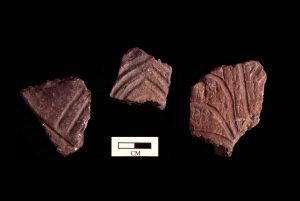 North Elkhorn Creek snakes through the gently rolling hills of bluegrass just north of Lexington, Kentucky. Small towns and large farms with long stone walls characterize this beautiful area, which also includes the remains of large Fort Ancient villages just below the surface. In 1997, archaeologists Gwynn Henderson and David Pollack, now of the University of Kentucky, documented the layout of Singer Village, a Fort Ancient site that archaeologists had known of for some time. They discovered that it consisted of two circular villages of different sizes and ages. The larger of the two continued onto the neighboring farm owned by the Hieronymus family. Two years later, they investigated the farm.
North Elkhorn Creek snakes through the gently rolling hills of bluegrass just north of Lexington, Kentucky. Small towns and large farms with long stone walls characterize this beautiful area, which also includes the remains of large Fort Ancient villages just below the surface. In 1997, archaeologists Gwynn Henderson and David Pollack, now of the University of Kentucky, documented the layout of Singer Village, a Fort Ancient site that archaeologists had known of for some time. They discovered that it consisted of two circular villages of different sizes and ages. The larger of the two continued onto the neighboring farm owned by the Hieronymus family. Two years later, they investigated the farm.
 They documented the portion of the Singer Village that continued onto the Hieronymus farm, but discovered that there were two more villages that had never been professionally documented. They named this complex of circular villages the Singer-Hieronymus Site Complex. This complex, which dates from A.D. 1200-1550, is unusual because it is comprised of four villages aligned along a broad ridge overlooking North Elkhorn Creek. Like other Fort Ancient villages, the inhabitants of Singer-Hieronymus mainly relied on corn, beans, and squash agriculture and hunting. Thousands of artifacts were recovered from the Singer and Hieronymus villages including debitage, ceramics, and chipped stone tools. These villages consist of concentric rings of middens, residences, and burials around a central plaza.
They documented the portion of the Singer Village that continued onto the Hieronymus farm, but discovered that there were two more villages that had never been professionally documented. They named this complex of circular villages the Singer-Hieronymus Site Complex. This complex, which dates from A.D. 1200-1550, is unusual because it is comprised of four villages aligned along a broad ridge overlooking North Elkhorn Creek. Like other Fort Ancient villages, the inhabitants of Singer-Hieronymus mainly relied on corn, beans, and squash agriculture and hunting. Thousands of artifacts were recovered from the Singer and Hieronymus villages including debitage, ceramics, and chipped stone tools. These villages consist of concentric rings of middens, residences, and burials around a central plaza.
But why were these four villages aligned along this ridge? Do they represent the movement of the same community over time? Was one village abandoned for a time and then a new one built when the inhabitants returned? Henderson surmised that the Singer-Hieronymus Site Complex contains the remains of one community as they sequentially moved over time. There is also the possibility that differences of opinion among the inhabitants precipitated village fission, spawning the construction of a second simultaneous village. There are still many questions that need to be answered and more research that needs to be conducted at this very important site.




